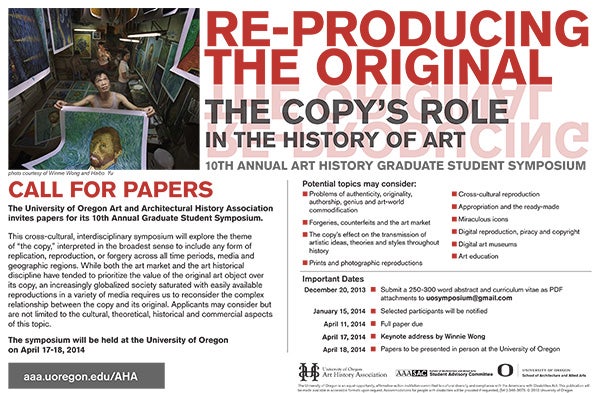Much debate and perplexity comes from the subject of authenticity in the art world. While an original work of art invariably has more value than a copy, the problem of distinguishing between the two has become especially concerning.
This year’s 10th Annual Graduate Student Symposium, titled “Reproducing the Original: The Copy’s Role in the History of Art,” is centered on the topic of authenticity, reproduction, and forgery throughout time. The University of Oregon Department of the History of Art and Architecture and the Art and Architectural History Association invite research papers for the symposium.
Dafen, a suburban village in southern China, is home to hundreds of art factories where artists produce hand-painted replicas of Western and Asian artists, including Andy Warhol, Vincent Van Gogh, Gustav Klimt, and many others. These replicas have intersected with the lucrative Chinese art market, conflating the genuine and replica.
Dafen’s art market, where five million paintings are replicated annually, has become the subject of a book due to release next year, “Van Gogh on Demand: China and the Readymade,” by Winnie Wong. Wong, a historian of modern and contemporary art with an emphasis in forgery, will make a keynote talk at the symposium on April 17, 2014.
Since society has found ease in media reproduction, the complicated relationship between an original work and its duplicate is forced into consideration.
“That [relationship] is the core idea of what we’re working with,” said Daniel Borengasser, co-coordinator of the symposium. “We’re shooting to deal with it in this symposium. It’s extremely complicated.”
Borengasser, a Washington University alumnus, is now a second-year graduate student in the history of art and architecture at UO. He is coordinating the symposium along with second-year graduate student Madeline Phillips, a graduate of State University of New York at Postdam.
Students are invited to submit a 250-300 word abstract for their research paper and curriculum vitae as PDF attachments to uosymposium@gmail.com by December 20. Selected participants will be notified by January 15, 2014. The deadline for the full-length paper is April 11, 2014, and the author will be expected to present the paper in person on April 18.
This opportunity is not exclusive to art history students, as the subject of originality and duplication is a concept that can be interpreted differently across a variety of disciplines, from literature plagiarism to business and copyright law.
“We thought about making the symposium about forgeries and how that’s affected the study of art, but that seemed kind of restricting. We want it to be much broader,” Borengasser said.
Applicants may write about—but are not limited to—the cultural, theoretical, historical, and commercial elements of this subject. Potential topics include:
• Problems of authenticity, originality, authorship, genius, and art-world commodification
• Forgeries, counterfeits, and the art market
• The copy’s effect on the transmission of artistic ideas, theories, and styles throughout history
• Prints and photographic reproductions
• Cross-cultural reproduction
• Appropriation and the ready-made
• Miraculous icons
• Digital reproduction, piracy, and copyright
• Digital art museums
• Art education
For more background on the phenomenon of art reproduction in China, read
“Forging an Art Market in China,” from The New York Times October 28, 2013; and
“Workshop of the world, fine arts division,” by James Fallows in The Atlantic (December 19, 2007)

